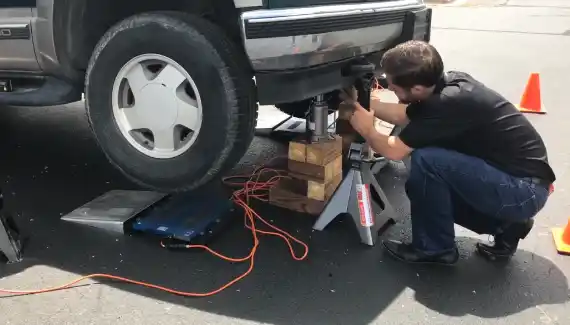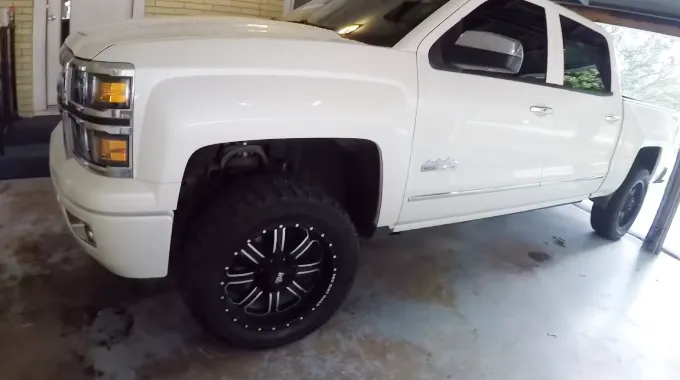Last Updated on April 12, 2023
Are you thinking about getting a lift kit for your truck? Before making the plunge, it’s essential to consider how much of an impact it can have on MPG (Miles Per Gallon).
Lifted trucks, RVs, and SUVs often suffer from decreased MPG due to several factors, such as increased weight, wind resistance, altered aerodynamics, changes in gearing, higher center of gravity, increased rolling resistance, altered tire pressure, and off-road use.
Poorly installed lift kits can further reduce fuel economy. But, a professionally-installed lift kit may have less of an impact on MPG. So what should you do?
Let’s discuss how this modification can affect fuel economy and what steps you should take to get the most gas mileage possible.
How Does a Lift Kit Affect Your Vehicle’s MPG?

Lift kits are an increasingly popular modification that can profoundly affect a vehicle’s (RV, SUV, truck, etc.) performance. While they offer numerous advantages, they also come with some drawbacks regarding fuel efficiency. Here is how lift kits affect MPG and the various factors that come into play.
Number 01: Increased Weight
One of the most significant ways lift kits affect MPG is through increased weight. This added mass requires more fuel to move, leading to a decrease in fuel efficiency.
Larger tires and suspension components are typically heavier than their stock counterparts and require more energy to move the vehicle. Moreover, increased weight can decrease acceleration times due to extra strain on the engine and affect braking performance due to added inertia.
Likewise, higher vehicle weights will also require more power from the drivetrain to maintain speed on inclines or while traveling at higher speeds. When equipped with a lift kit, these factors reduce the vehicle’s overall fuel economy.
Number 02: Increased Wind Resistance
Lift kits essentially operate by changing the profile of a vehicle from a more sloping and curving aesthetic to one with a bigger, more pronounced shape. This change can increase air resistance and turbulence around areas such as the wheels and bodywork due to reduced aerodynamic efficiency.
The vehicle’s engine is then put under extra strain when pushing through this added drag force at higher speeds or over longer distances. Consequently, fuel economy is significantly hampered as increased wind resistance directly impacts overall MPG figures.
Number 03: Altered Aerodynamics
Lift kits often alter the aerodynamic shape of a vehicle by raising it off the ground and making it boxier overall. This change in shape disrupts the airflow around it, creating turbulence and reducing its efficiency through increased drag.
Due to wind resistance alone, this can result in a decrease in fuel efficiency when driving at highway speeds. Also, larger tires with taller sidewalls create more rolling resistance than smaller ones. This further increases drag and hinders performance.
Number 04: Changes in Gearing
The gearing must be adjusted to match the larger tires when installing a lift kit. This is because a larger tire rotates more slowly than a smaller one, requiring a different gear ratio to achieve the same speed.
A change in gearing can negatively impact fuel economy by increasing engine drag, as the engine must work harder against the increased resistance. Moreover, this increase in drag will put additional strain on the engine and other components of the vehicle. This can require more maintenance and lead to decreased efficiency.
Number 05: Higher Center of Gravity

The higher center of gravity associated with a lifted vehicle means it is less stable than its stock counterpart. This can cause difficulty when driving on uneven terrain or sharp turns, as the driver may require more effort to control their vehicle.
As such, drivers may need more fuel to compensate for this instability, reducing fuel economy. While driving a lifted vehicle, a driver who doesn’t take appropriate precautions (like reducing speed or taking wide turns) could tip the car over or lose control, resulting in serious accidents.
Number 06: Increased Rolling Resistance
While larger tires may appear to be a more efficient and often more aesthetically pleasing option when it comes to modifying vehicles, they can also have unfavorable effects on fuel efficiency.
This is due to increased rolling resistance due to air resistance, road contact forces, and any additional weight added through suspension modifications (such as with a lift kit).
Therefore, drivers should be aware that larger tires may reduce acceleration capabilities and slower top speeds, meaning more fuel could be required for the same journey than if smaller tires had been fitted in the first place.
Number 07: Altered Tire Pressure
Lift kits often require higher tire pressure to ensure proper suspension and stability. While this is necessary for safety, it can drastically reduce fuel economy.
Higher tire pressure increases rolling resistance, which requires more energy to overcome. This means that the engine has to work harder to move the vehicle forward, thus consuming more fuel than normal.
Also, larger tires can change the vehicle’s gearing ratio, reducing efficiency. Drivers must consult a mechanic when installing a lift kit and adjust their tire pressure accordingly to maximize fuel efficiency.
Number 08: Altered Driving Style
When a car or RV is lifted, it may handle differently due to its new center of gravity and altered suspension. As such, some drivers may be tempted to take corners faster or brake harder than usual to experience the thrill of driving a lifted automobile.
Unfortunately, this aggressive driving style reduces fuel efficiency as it increases air resistance and causes unnecessary wear on brakes and tires. Drivers should practice defensive driving and maintain slower speeds while turning corners to conserve fuel when driving a lifted car.
Number 09: Off-road Use

Off-roading vehicles with lift kits are equipped with higher suspension and heavier-weight components necessary for navigating through rugged terrain, resulting in more fuel consumption.
Also, off-roaders often need to quickly start, stop, or change directions, thus consuming more fuel than on-road vehicles traveling at similar speeds. Starting, stopping, and changing directions require extra power from the engine that wouldn’t usually be needed if staying at a constant speed.
Hence, these situations will cause a decrease in MPG when compared to a typical driving situation.
Number 10: Poorly Installed Lift Kit
Installing a lift kit correctly and professionally is paramount to ensure the safe drivability of your vehicle. When done incorrectly, multiple issues can arise, which will strain both the driver and the car itself.
Poorly made alignments or otherwise incorrect suspension settings can cause reduced control over the RV truck or others and deficits in fuel economy caused by running properly balanced components such as tires.
On top of this, vibrations at high speed could be caused by incorrect installations and consequently result in extra wear on the engine, resulting in further lost MPG.
Therefore, it is essential that any lift kits installed onto a vehicle are handled carefully and loaded appropriately so to maximize safety and efficiency.
How Much Does a Lift Kit Decrease MPG?
A lift kit can significantly reduce a vehicle’s MPG (miles per gallon). The extent of the decrease depends on many factors. Generally speaking, the type of lift kit, size of tires, weight of the vehicle, driving conditions, and driving style all play an essential role in determining how much MPG will be decreased.
While it is difficult to assign an exact figure for how much a lift kit decreases MPG since many factors are involved, generally speaking, it could range from 1 to 5 miles per gallon or even higher depending on the abovementioned elements.
Therefore, drivers considering a lift kit install must consider not only style and performance but also their MPG before making any final decisions.
Why Do Lift-kits Trucks Get Worse Gas Mileage?

Gas mileage on a lifted truck is typically lower than on a stock truck due to the additional aerodynamic drag created by the higher body. This effectively puts more strain on the engine, which consumes more fuel.
It’s worth pointing out that when a vehicle travels at higher speeds, like on highways or freeways, the drag is even greater, so MPG can be significantly reduced.
Also, any extra weight from aftermarket components, such as larger tires and suspension systems, will affect MPG as they require more energy to move through the air.
What Can I Do To Improve My Lifted Trucks Gas Mileage?
You can take several steps to improve your lifted truck’s gas mileage:
- Ensure that all of your tires are properly inflated and balanced, as this can help reduce drag and improve MPG.
- Consider installing an air dam under your vehicle’s front end, which helps reduce air resistance and improves aerodynamics.
- Having your engine regularly tuned by a professional mechanic can also help optimize its performance and improve fuel economy.
Other measures you could take include reviewing your driving habits. Avoid sudden stops or starts and switch off unnecessary accessories when not in use, such as overhead lights or entertainment systems.
All these steps combined can significantly improve your lifted truck’s MPG and provide cost-effective savings.
Increase Your Lifted Vehicle’s Performance without Compromising MPG
Installing a lift kit on your truck, SUV, Rv, or other vehicles can affect its fuel economy. An increase in weight and wind resistance combined with altered aerodynamics and changes in gearing are the primary reasons lifted trucks experience lower gas mileage.
But, there are some measures you can take to combat this decline in MPG, such as adjusting tire pressure and the driving style or using high-quality components during the installation process.
With proper maintenance and care, you can ensure that your lifted truck will have optimal performance without sacrificing too much in terms of MPG.
